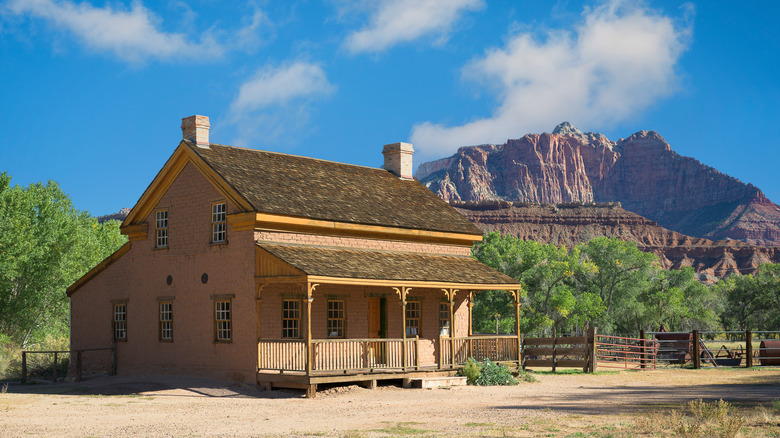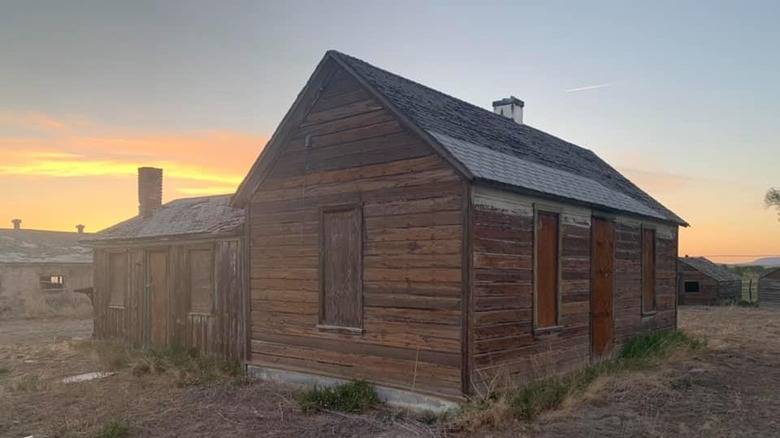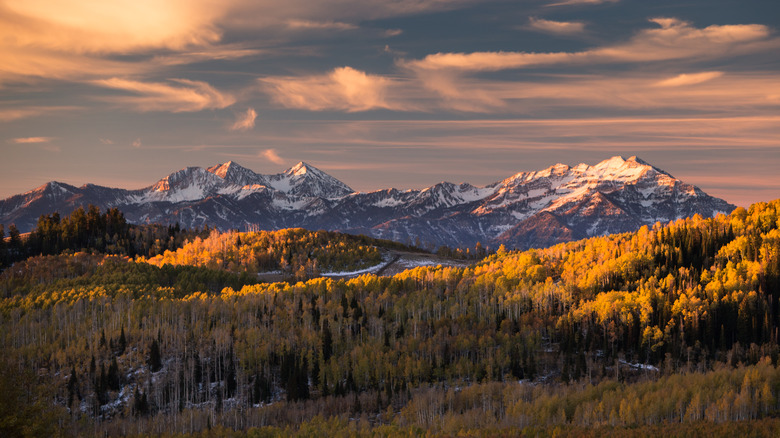
Utah is full of ghost towns left over from when Americans journeyed west in the 1800s. Some of these still have buildings, gravesites, and other signs of the people who once lived in these communities, while others are only patches of land steeped in history. Most, like the abandoned ghost town of Grafton, Utah, were settled by Mormons and are a part of the history of the Church of Jesus Christ of Latter-day Saints. One, however, tells a different story.
The rural city of Gunnison is perfectly placed
to be a central stop on your road trip from Salt Lake City to Utah's impressive red rock destination, Capitol Reef National Park. In Gunnison, you'll find all that remains of the Clarion Colony: An information kiosk in a little town center known as Legacy Wall and, on nearby farmland, a pair of tombstones carved with both English and Hebrew epitaphs.
Clarion was an early-1900s attempt to build a Jewish settlement in Utah. It was a part of a larger movement of Jewish immigrants who were starting farming communities in the West at this time. They sought religious freedom and escape from the poverty they had experienced in America's bigger cities. These settlements didn't last, though, and Clarion faded into nothing more than a memory. Even the graves of those who had lived there were mostly forgotten -- until 1981, when historian Robert Goldberg, from the University of Utah, found the graves and brought them back into the public eye, managing to bring together the descendants of those who founded Clarion. While there may not be much left to see, for those who know the history, a trip to see the remains of Clarion can be a fascinating and even moving experience.
Read more: The 5 Best Parks Where You Can See Bison Roam (Other Than Yellowstone), According To Visitors
What Was Clarion And Why Was It Abandoned?

The Jewish community of Clarion was founded in 1911 by eighty-one Jewish families from Philadelphia, New York, and Baltimore. Many of them were immigrants to the United States from Eastern Europe who embarked on their journeys west, hoping to start a new life away from the big city.
The experiment was supposed to provide opportunities for these families to enjoy the wide open land in Utah and to sustain themselves through farming. The community chose Utah as a place where they felt they might be free from oppression and persecution because it had also become a homeland for Mormons, another religious minority in the United States. While the Jewish families who came to Clarion were welcomed by the local Mormon community in Gunnison, the group struggled. One major issue was the lack of drinkable water, worsened by the fact that their cistern quickly broke. Poor-quality soil, badly-timed frosts, and horrendous flooding all took tolls on the community. There were also cultural clashes among the colonists.
Religion was their only uniting factor, meaning that politics often divided the group. The colonists ranged from passionate anarchists and socialists to devout Orthodox believers. Each individual had radically different visions for what the colony should become, and what started as a cooperative community quickly became separate farms run by different families. After several failed harvests, the majority of the colonists went back east. The colony only lasted for five years, though several families chose to stay on the land that was once the Clarion colony long after the colony itself had technically dissolved.
Discover Important Gravesites From The Clarion Colony

If you're interested in learning more about this fascinating moment in American history, you may want to visit the graves of the Clarion colony, which are only about ten minutes away from Gunnison. There, you'll find the grave of Aaron Binder, one of the first 12 settlers to arrive in Utah to prepare the land that would become Clarion. Unlike many of the colonists, Binder was not dreaming of a new homeland for America's Jewish population or trying to start a political movement; he simply loved the idea of living off the land.
Binder was known to be extremely strong and fit, and he helped to endear the local Mormon community to the new Clarion Colony. His farm was reported to be the best and most productive in Clarion, but tragically, he was killed when his wagon flipped over in Utah's majestic Wasatch Mountains. You will also see the grave of a baby named Isaac Lieberman. He was only ten months old when he died during the long, hard winter of 1914, when many of the colonists in Clarion were starving. His grave is adorned by carvings of lambs and the Star of David.
Visiting these graves is easier said than done, as they are located on private property that is used for cattle grazing. In a 2008 article from the Salt Lake City Tribune, however, the farmer who owned the land noted that he had been tending to the graves. Since noticing the burial sites as a teenager, he stated that he took time to honor the dead and that he welcomed visitors who wished to seek them out. The closest you can get without seeking permission from the land owner is West Clarion Road.
Ready to discover more hidden gems and expert travel tips? Subscribe to our free newsletter for access to the world's best-kept travel secrets.
Read the original article on Islands.













